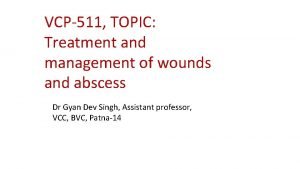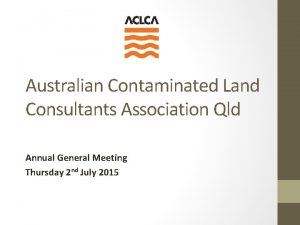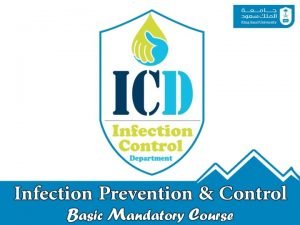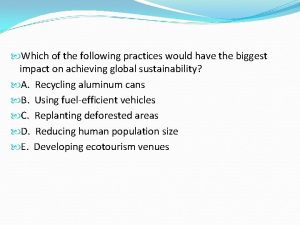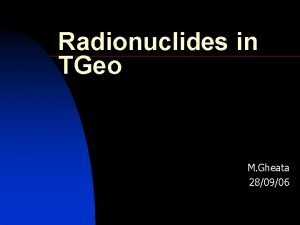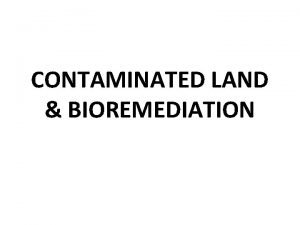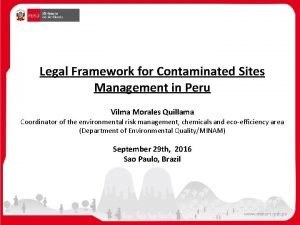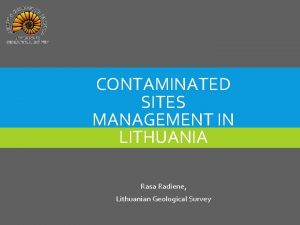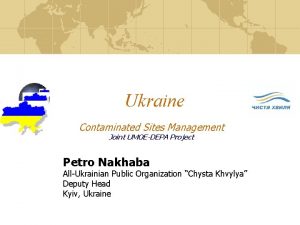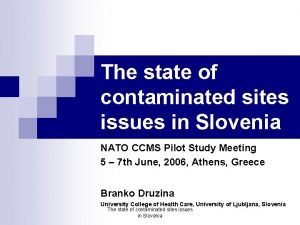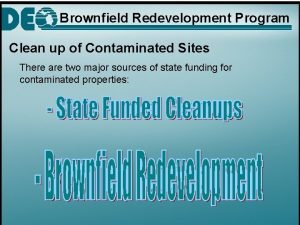Management of industrial sites contaminated with radionuclides in










- Slides: 10

Management of industrial sites contaminated with radionuclides in France Outline 1 Background The requirements • seeking for consistency with other regulations • seeking for a pragmatic approach – a step by step assessment process, – a generic approach aimed at solving the “simple” cases, – getting out of the process as early as possible. A. Oudiz et al, 29 october 2003 1

Management of industrial sites contaminated with radionuclides in France Outline 2 • From risk management to site management • Need for a stakeholders’ involvement • A pragmatic approach to optimization A. Oudiz et al, 29 october 2003 2

Methodology Background • Industrial sites : those contaminated with long-lived radionuclides as a legacy of earlier activities (radium luminizing, uranium metallurgy, flint industry, …). • 238 U, 232 Th, 226 Ra and daughters, 90 Sr, 137 Cs, 3 H, 14 C, … • Current policy was set up in mid 1990 s on a case by case basis, e. g. 226 Ra: – outdoor 5 Bq/g of soil and 1 Gy/h, – indoor 1 Bq/g of soil and 0. 2 Gy/h, – non fixed contamination: 1 Bq/cm 3 of material collected. A. Oudiz et al, 29 october 2003 3

The requirements (1) • Seeking for consistency with other regulations – New site remediation policy must be consistent with EC May 1996 BSS directive, hence with ICRP 60. – New remediation policy of radio-contaminated industrial sites should be as much as possible consistent with remediation policy of sites contaminated with chemicals. • Seeking for a pragmatic approach – A procedure with 6 stages : removal of doubt, pre-diagnosis, initial diagnosis, simplified risk study, detailed risk study, assistance in the selection of the remediation strategy. A. Oudiz et al, 29 october 2003 4

The requirements (2) • A generic approach aimed at solving the “simple” case – based on 5 scenarios: residence, school, truck farming, car park, offices, – conservative hypotheses for the individual effective dose and external dose rate calculations associated with 1 Bq/g of soil for 238 U, 232 Th, 226 Ra and daughters, 90 Sr, 137 Cs, 3 H, 14 C, … – examples : • residence, 226 Ra family : effective dose 460 Sv/yr ; external dose rate 0. 37 Sv/h • car park, 226 Ra family : effective dose 11 Sv/yr; external dose rate 0. 055 Sv/h A. Oudiz et al, 29 october 2003 5

The requirements (3) • Getting out of the process as early as possible – For the future site’s use, if the effective dose is < SL, then there is no need for remediation. An easement may be required to avoid changing this use in the later. – SL is the “selection level”, expressed in m. Sv/yr, which must be defined by authorities. – Example : for SL = 1 m. Sv/yr, a car park may be an appropriate use of a site contaminated with 226 Ra family (at equilibrium), provided that the 226 Ra activity content is < 90 Bq/g of soil A. Oudiz et al, 29 october 2003 6

From risk management to site management • For large sites, involving various and expensive remediation techniques, with several potential future uses (i. e. “complex sites”), radiation risk acceptability closely depends on the benefits expected from the future uses. • Stakeholders will choose a remediation strategy and a use which constitute a good compromise between several needs: – – reduce the radiological impact of the contamination, avoid depreciation of the zone and local products, create economic and social activities, avoid very expensive remediation techniques. A. Oudiz et al, 29 october 2003 7

Need for the stakeholders’ involvement • Stakeholders : administration, elected representatives, experts, operators, residents’ associations, environmental associations, … • Consultations allow a risk assessment process integrating local features and contribute to social trust. • Consultations contribute to a better understanding of what is at stake for those involved. Choices likely to modify some of the local habits may be supported then, if the benefits linked to the remediation strategy appear clearly. • Extent of the consultations will depend on the social and technical context. A. Oudiz et al, 29 october 2003 8

A pragmatic approach to optimization (1) • Remediation strategies = combination of remediation techniques (soil removal, soil confinement, shielding, waste transportation. . . ) to be implemented in all or parts of the site. • For “complex” sites, the use of decision aiding techniques (cost-benefit analysis, …) is not recommended for the choice of the appropriate strategy. • Instead, various alternative strategies should be presented to the stakeholders. Experts should elaborate, in cooperation with stakeholders, tables providing a synthetic information for each strategy. A. Oudiz et al, 29 october 2003 9

A pragmatic approach to optimization (2) • Information to be presented for each strategy – – – – reduction of doses and of contamination, investment and maintenance costs, duration of the strategy, doses to the workers implementing the strategy, nuisances during implementation, needs for long term maintenance of the remediation techniques, needs for long term site monitoring, potential for reversibility. A. Oudiz et al, 29 october 2003 10
 Radionuclides
Radionuclides Define industrial estates
Define industrial estates Contaminated wound
Contaminated wound Newsworthy event (s) background event (s) sources
Newsworthy event (s) background event (s) sources Australian contaminated land consultants association
Australian contaminated land consultants association Definition of contaminated
Definition of contaminated Contaminated product insurance
Contaminated product insurance Which of the following
Which of the following Xeomin reconstitution chart
Xeomin reconstitution chart Pulses location
Pulses location Location of apical pulse
Location of apical pulse


